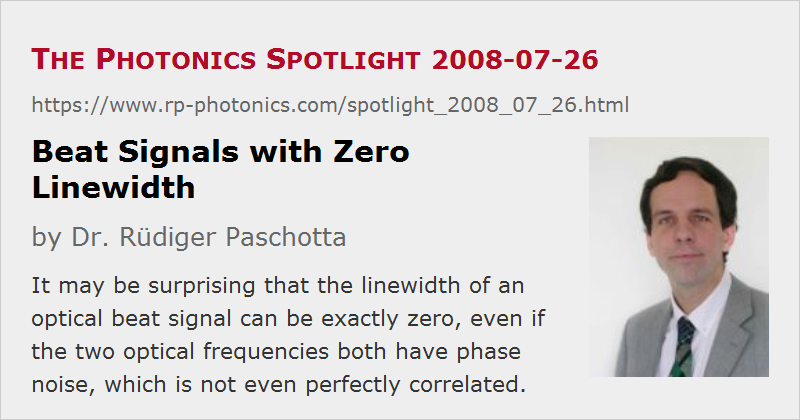Beat Signals with Zero Linewidth
Posted on 2008-07-26 as a part of the Photonics Spotlight (available as e-mail newsletter!)
Permanent link: https://www.rp-photonics.com/spotlight_2008_07_26.html
Author: Dr. Rüdiger Paschotta, RP Photonics Consulting GmbH
Abstract: It may be surprising that the linewidth of an optical beat signal can be exactly zero, even if the two optical frequencies both have phase noise, which is not even perfectly correlated.

Ref.: encyclopedia articles on beat note, linewidth, frequency metrology
A single-frequency laser always has some finite linewidth. Therefore, one should expect that the beat note between two lasers also always has to have a finite linewidth. Curiously, however, there are cases where the beat linewidth is exactly zero, not just very small.
Such cases are not even rare. In optical frequency metrology, a laser frequency is often stabilized such that it has a constant offset frequency against some other optical frequency. The offset frequency is given by some electronic precision oscillator, and the feedback loop can lock the relative frequency in a phase-stable way. The beat note then still exhibits some phase noise, as no feedback loop can totally suppress noise. Nevertheless, the beat linewidth can be exactly zero if the phase error exhibits only fluctuations within some finite small interval. In the beat spectrum, the noise shows up as some weak noise background, above which there is a zero-linewidth peak.
To be precise, phase noise of the mentioned electronic oscillator can of course be transferred to the beat note and thus cause a non-zero linewidth. However, a zero linewidth is measured if the beat signal is analyzed based on a clock which is in synchronism with the oscillator.
Another part of the small print is that a zero linewidth is actually only reached for infinitely long measurement times. However, we can definitely attribute a zero linewidth to a signal where the measured linewidth can be arbitrarily small if the measurement time is made long enough.
How can we actually understand a zero linewidth? It means that there is absolutely no long-term phase drift, even though there can be short-term phase fluctuations. If you compare such a signal with a perfect sinusoidal signal of the same frequency, it will never get out of sync. On the other hand, if you introduce only the slightest detuning between the signal and that reference signal, synchronism will be lost over time; in other words, the linewidth is zero. For a free-running oscillator, synchronism with some reference will always be lost sooner or later, so the linewidth is always finite.
This article is a posting of the Photonics Spotlight, authored by Dr. Rüdiger Paschotta. You may link to this page and cite it, because its location is permanent. See also the RP Photonics Encyclopedia.
Note that you can also receive the articles in the form of a newsletter or with an RSS feed.
Questions and Comments from Users
Here you can submit questions and comments. As far as they get accepted by the author, they will appear above this paragraph together with the author’s answer. The author will decide on acceptance based on certain criteria. Essentially, the issue must be of sufficiently broad interest.
Please do not enter personal data here; we would otherwise delete it soon. (See also our privacy declaration.) If you wish to receive personal feedback or consultancy from the author, please contact him e.g. via e-mail.
By submitting the information, you give your consent to the potential publication of your inputs on our website according to our rules. (If you later retract your consent, we will delete those inputs.) As your inputs are first reviewed by the author, they may be published with some delay.
 |




If you like this page, please share the link with your friends and colleagues, e.g. via social media:
These sharing buttons are implemented in a privacy-friendly way!